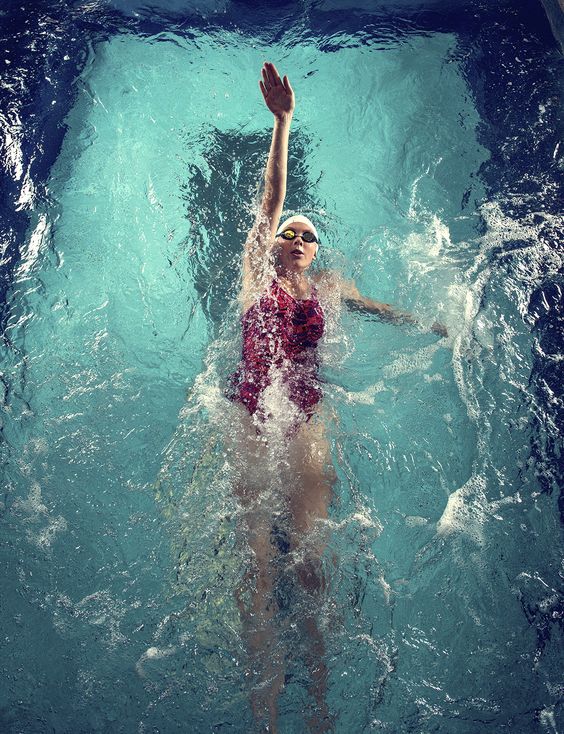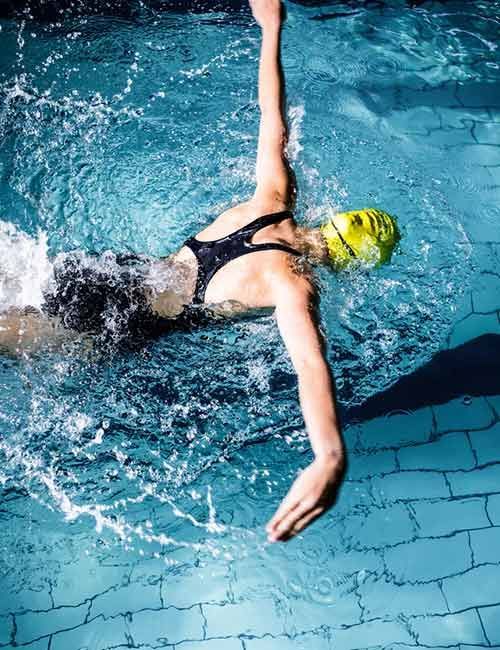When it comes to swimming, there are four fundamental types of strokes that every aspiring swimmer should know. These strokes, namely freestyle, breaststroke, backstroke, and butterfly, each have their own unique characteristics and techniques. In this comprehensive guide, we will talk about the details of each stroke, highlighting their key features and providing valuable insights to help you master them with precision.
Introduction
Freestyle:
The fastest and most commonly used stroke in competitive swimming.
Involves alternating arm movements in a windmill motion.
Utilizes a flutter kick, where the legs kick in an up-and-down motion.
The swimmer’s face is in the water, and breathing is done by turning the head to the side during arm recovery.

Breaststroke:
Often considered the most traditional and recognizable stroke.
Arm movements consist of a simultaneous pull, followed by recovery in a circular motion.
The kick involves a powerful frog-like motion, with the feet turning out and drawing towards the body.
The swimmer’s face is out of the water during the arm recovery phase, allowing for easy breathing.

Backstroke:
Swum on the back, with the face looking up towards the ceiling or sky.
Arm movements involve alternating windmill-like motions, with the palms facing outwards.
The legs perform a flutter kick, similar to the freestyle stroke.
Breathing is done by coordinating the rotation of the head with the arm movements.

Butterfly:
Known for its distinctive dolphin-like movement.
Arm movements are simultaneous and executed in a circular motion, with the hands entering the water above the head.
The kick involves a powerful dolphin kick, with both legs moving in unison.
Breathing is done by lifting the head slightly out of the water during the arm recovery phase.

How to learn the four types of swimming strokes ?
Learning the four basic swimming strokes – freestyle, breaststroke, backstroke, and butterfly – requires practice, proper technique, and patience. Here are some steps to help you learn and improve each stroke:
Freestyle :
Start by floating on your stomach and practice kicking using a flutter kick motion.
With arms extended, practice the arm movements by pulling one arm through the water, bending at the elbow, and then recovering it above the water while the other arm starts the pull.
Combine the flutter kick and arm movements, alternating arms and maintaining a steady, rhythmic motion.
Focus on body position, keeping your head aligned with your body and breathing to the side during the arm recovery phase.
Breaststroke:
Begin by floating on your stomach with your arms extended forward.
Practice the arm movements by sweeping your arms out to the sides, then bringing them together in front of you, making a circular motion.
Coordinate the arm movements with the leg kick, which involves drawing your feet towards your body and then pushing them outward in a frog-like motion.
Ensure proper timing by synchronizing the arm pull with the leg kick.
Remember to keep your head in a neutral position and breathe in coordination with the arm movements.
Backstroke:
Start by floating on your back with your arms extended overhead.
Practice the arm movements by alternating windmill-like motions, with your palms facing outward as they enter the water.
Focus on a relaxed and steady arm motion, keeping your elbows slightly bent.
Coordinate the arm movements with a flutter kick, ensuring that your legs remain close to the surface of the water.
Practice rotating your head with each arm stroke to breathe.
Butterfly:
Begin by practicing the dolphin kick. Lie on your stomach and practice kicking your legs together in a dolphin-like motion, generating power from your hips.
Once comfortable with the kick, add the arm movements. Start with your arms extended forward, then simultaneously pull both arms in a circular motion while your legs kick.
Focus on maintaining a fluid and rhythmic motion, coordinating the arm pull with the leg kick.
Breathe by lifting your head slightly out of the water during the arm recovery phase.
As the butterfly stroke can be physically demanding, gradually build up your strength and endurance.
Conclusion
Remember, learning and mastering each stroke takes time and practice. Consider taking swimming lessons from a certified instructor who can provide feedback and guidance. Video analysis can also be helpful in identifying areas for improvement. Practice regularly, maintain proper body alignment, and focus on developing efficient technique for each stroke.


